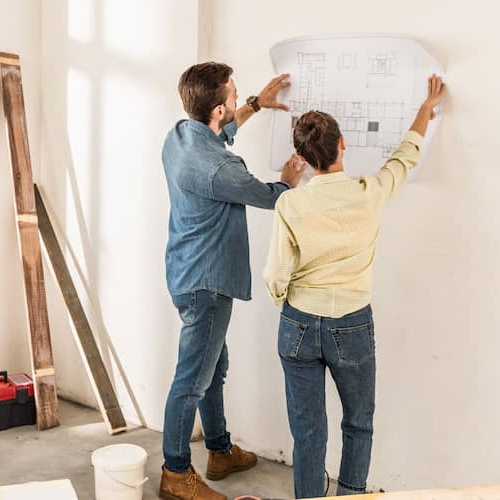How to recover after a natural disaster: A guide
May 26, 2023
•7-minute read
Natural disasters can upend years of hard work and stability in as little as a few minutes. If you’ve been through a natural disaster before or you’re going through it right now, a certain amount of shock is understandable. There can be so much to do that you may not know where to start.
In the aftermath of a disaster, the most important thing to take care of is the safety and well-being of you and your family. Once things have stabilized a little bit in the area, it’s time to figure out the best way to move forward and begin disaster recovery.
The goal of this post is to give you the resources to recover after a natural disaster. Before we get into that, take a deep breath, and remember to take things one step at a time. What Mother Nature destroyed in minutes could take months to rebuild, but you can do it. You’ll get through this.
What to do right after a natural disaster strikes
Even with a disaster preparedness plan in place, natural disasters can still cause challenges for those affected. In the event’s immediate aftermath, there are a couple of things you can do to make sure the rest of this process goes as smoothly as possible.
Call first responders
The first concern after a natural disaster is you and your family’s safety. Calling first responders and local authorities, such as firefighters, paramedics and police is vital if there are people stuck in a dangerous situation after the disaster strikes. Let local officials know if there are any major roadblocks or if food and shelter is needed.
Find emergency shelter if needed
You can find an emergency shelter if needed by texting “DRC” and your ZIP code to 43362. Doing so will connect you with someone who can assist you from the Disaster Recovery Center, which is nationwide. An emergency shelter may be needed if you are not able to make it back to your home safely or your home is unsafe to live in.
Account for all loved ones affected by the disaster
If you are not with your family during the time of the storm, be on the lookout for your loved ones after disaster strikes to assess their safety and then make decisions from there. If first aid is needed, do not attempt to move them unless they are in immediate danger. If they are unconscious, stabilize the neck and back then call for first responders immediately.
Secure your personal belongings
There are a few things you can do to protect your personal information. Get in touch with creditors immediately and report any lost credit cards. Your bank will be able to help you replace lost checks or a bank card. You can also shred any papers with personal information that you find when cleaning up so identity thieves can’t use it for their own purposes.
You can place a 3-month fraud alert with the three major credit bureaus – Equifax®, Experian™ and TransUnion® – so that creditors have to call you in order to make sure you’re the one actually applying for any kind of credit. This could be especially useful if you had to take off in a hurry.
Document the damage
Before making any repairs, you want to document the full extent of the damage for the insurance company. You can do this by taking pictures, including any debris. Keep careful records of anything that was damaged in the affected areas.
You’ll need this when it comes time to talk about the settlement with the insurance company so that you can get accurate replacement value.
Register for disaster relief
The Federal Emergency Management Agency (FEMA) offers all sorts of assistance for people whose area has been declared a disaster area by the federal government. As a victim of natural disaster, you can register for disaster relief and you can apply for grants designed to help with rebuilding. You can submit your FEMA assistant application through the link, but keep in mind that they can only offer disaster assistance for damages that are not covered by insurance. You will receive a response that explains what assistance you are eligible for and how the assistance can be used.
How to rebuild after a natural disaster
When it’s time to rebuild, there are a few important steps to take into consideration. Among them, you need to think about what your insurance covers, and what your options are for alternative funding to insurance.
Work on damage prevention
You don’t want to start making permanent repairs until an insurance adjuster has seen your property to fully evaluate any damage. Your insurance company may be able to advise you on next steps.
As a homeowner, you’re responsible for preventing any further damage being done before the repair is completed. With that in mind, you should begin thinking about temporary repairs. The exact steps you’re going to take will depend on damage, but here are a few common areas that may need some attention. Don’t forget to document your cost for all these temporary repairs, as your insurance company may reimburse you.
- It’s important to reiterate: Don’t make any permanent repairs before the adjuster has been to the property. This will likely hamper your ability to get reimbursed if they don’t know the full extent of the damage.
- Rip out wet drywall and carpet to prevent the spread of mold.
- Use boards to close openings on the property.
- Put up tarps.
- Installing fencing will protect your belongings and prevent bystanders from getting hurt by entering unstable areas.
- Avoid fly-by-night contractors. You don’t want someone who’s just out to make a quick buck working on your home. Be sure they’re licensed and have good references.
Make a homeowners claim
One way to get your home repaired is to make a homeowners claim. If you plan on using your homeowners insurance to cover the cost of repairs, there are a few things you need to know.
Be sure to know what your insurance covers. If you don’t know the exact terms, contact your provider and ask them for a copy of your policy. Unfortunately, flooding is typically not covered and requires an additional flood policy. Unless you’re in an area particularly susceptible to flooding, in which case your mortgage company may require you to carry the additional coverage. Your homeowners insurance deductible is often just taken out of any funds you would receive for your claim.
Depending on the amount of your claim, your mortgage lender may have to schedule inspections to make sure that your home is being restored to a condition that’s as good or better than it was before the damage. The reason for this is that major mortgage investors like Fannie Mae, Freddie Mac, the FHA and the VA need to protect their investment in your home in case you fall on hard times and they need to sell your home.
Depending on the scope of the claim, repairs may be done in stages, with your home insurer issuing checks incrementally for the work rather than the full amount. In this case, multiple inspections would be set up by your lender.
When you were in the process of getting a mortgage, your lender likely required you to have homeowners insurance to protect the investment. In this situation, your mortgage lender will be listed on the homeowners policy as well. Your lender will need to endorse the check before you can use it to pay for repairs.
Talk to your mortgage lender
As a homeowner, you should talk to your mortgage lender if you become financially unable to pay the mortgage in order to avoid foreclosure in the future. Keep in mind that a lender can proceed with the foreclosure process when the loan is at least 120 days delinquent, with some exceptions. A lender will also attempt to contact the borrower about the missed payments in order to work out a solution.
Find temporary housing
If the rebuild is going to take a while, you may need to find somewhere to call home temporarily. There are a couple of ways of going about this.
FEMA has a great site where you can find hotels with rooms that the agency will temporarily pay for to help you transition. You may be able to utilize your homeowners insurance during this process as well. If you’re going to be out of your home for an extended period, it may be cost-effective to look at renting an apartment. Whether it makes more sense to go with a rental agreement or lease will depend on how long you anticipate staying. You may want to shop around to avoid opportunistic price gouging.
Be sure to know which amenities are included in the terms of any agreement. Also, keep your receipts. Your insurance company may reimburse you for the cost of temporary lodging.
Find disaster-related help where you live
If you need disaster assistance with expenses – or filing a homeowners insurance claim isn’t possible or doesn’t make sense for you – there are other sources of funding to help you rebuild.
FEMA offers a variety of assistance for people whose area has been declared a disaster area by the federal government. You can also apply for grants designed to help with rebuilding. Check out all of the resources FEMA offers.
In addition, you can find local resources for your area on this page if your state has set up branches of its emergency management agency anywhere near you. The American Red Cross also helps with food, shelter, recovery plans and medical care on a temporary basis during disasters.
Another good resource is the Small Business Administration (SBA). The SBA offers low-interest disaster relief loans for businesses of any size, nonprofits and even homeowners. They can be used to replace real estate, personal property, machinery and equipment, and inventory or business assets.
How to return to normalcy post-natural disaster
One of the biggest hurdles to overcome after a natural disaster is the mental challenges that dealing with all of this can bring. While the rebuilding process can take a long time, it’s important to remember that there are small steps that you can take to help regain normalcy.
Get back into a routine
Getting back into a routine every day is essential in order to feel productive and positive after experiencing a natural disaster. Creating a new routine can help improve your mental health, but remember to pace yourself and give yourself time and space to rest.
Make a plan
An important aspect of disaster recovery is finding the positivity in your own life. Creating a plan for your work life, personal life and home life is essential to moving forward. Get connected with your coworkers, friends and family and find ways to support each other during the recovery period.
Seek professional counseling
The mental toll that a natural disaster has on its victims can be profound. Seeking professional counseling for yourself and the entire family may help to work through the many emotions involved with experiencing a natural disaster. Reaching out for help is a sign of strength and resilience during a tough time.
Stay involved in the community
Helping your local community rebuild after a natural disaster can bring you and other people together to promote positivity and change. While it’s normal to feel overwhelmed and drained after this type of event, staying active and helping your community can offer you and your neighbors hope as everyone moves forward. There are often volunteer opportunities at emergency shelters, building sites and aid tents.
The bottom line: Recovering from a natural disaster is a long process
Recovery after a natural disaster can seem like an overwhelming, long journey but it’s possible to get through with the right resources and support. With these tips, the journey to get your life together after a disaster can hopefully be a time of healing and growth. Reach out for disaster assistance, keep your family healthy and prioritize mental health during the recovery period.
If you are looking to prepare for the future, learn more about how hazard insurance can help protect your home.
Kevin Graham
Kevin Graham is a Senior Writer for Rocket. He specializes in mortgage qualification, economics and personal finance topics. Kevin has passed the MLO SAFE exam given to mortgage bankers and takes continuing education courses. As someone with cerebral palsy spastic quadriplegia that requires the use of a wheelchair, he also takes on articles around modifying your home for physical challenges and smart home tech. He has a BA in Journalism from Oakland University.
Related resources

6-minute read
How you can change homeowners insurance with escrow
Want to change your homeowners insurance? Read through our step-by-step guide on how to change your homeowners insurance with an escrow account.
Read more

7-minute read
What home improvements are tax-deductible? IRS rules and eligible upgrades
Are home improvements tax-deductible? Learn what improvements you can deduct from your taxes, what counts as a capital improvement, and how the IRS decides.
Read more

6-minute read
What is a seller’s pre-inspection?
As a seller, you might order a pre-inspection before listing your home to address any repairs and help prevent negotiations with buyers. Find out how it works.
Read more